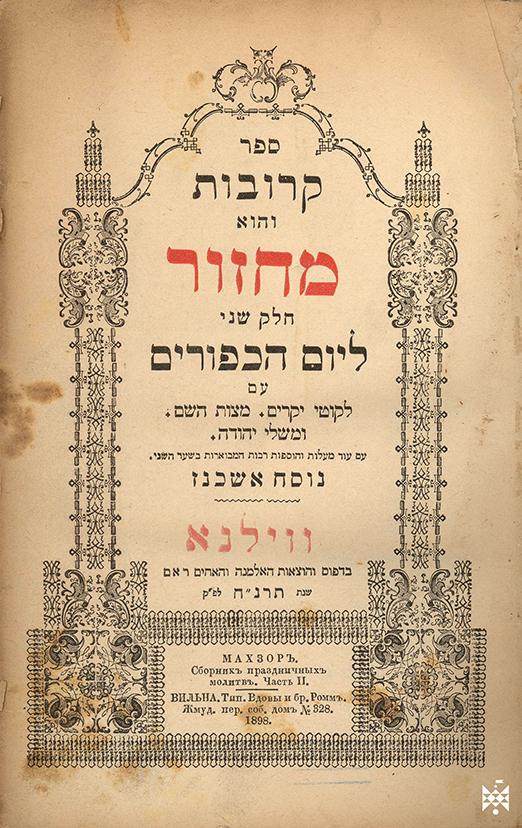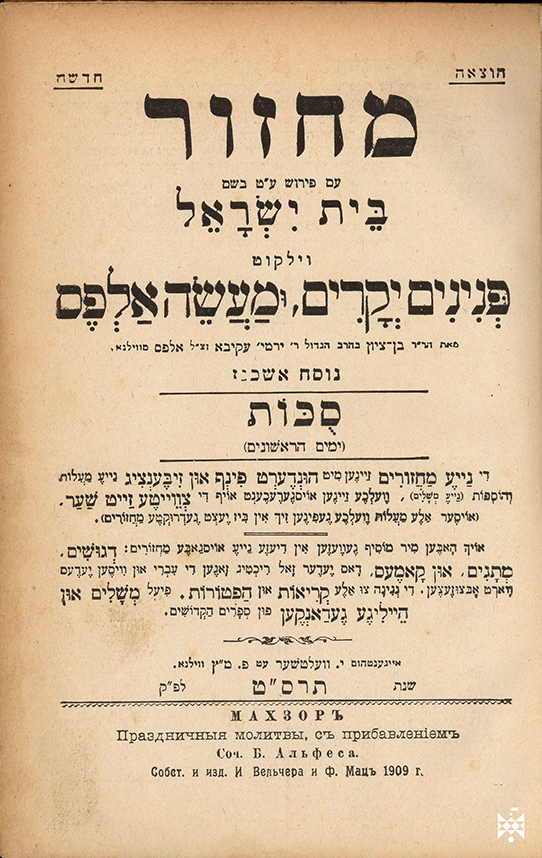Exhibit of the month |
← |
Published: 2023-08-31
Rosh Hashanah Machzor (Jewish New Year’s Prayer Book), Vilnius, 1892, Acc. No. VŽM 8710 (Picture 1)
According to the Jewish calendar, on the evening of 15 September this year, the New Year, Rosh Hashanah 5784, begins, and with it the month of Tishri – the first month of the Jewish year, roughly corresponding to the second half of September and the first half of October. The month of Tishri is distinguished by an abundance of traditional Jewish holidays. They are all held in the second half of September this year – only Sukkot falls in October. Special prayer books – machzors – are used for these holidays.
To mark this occasion, we invite you to take a look at one very special collection of Jewish scriptures held at the Vilna Gaon Museum of Jewish History. It is a collection of books from the Jewish community of Bradford in the UK. A few years ago, a representative of this community donated over 70 books to the museum, most of them scriptures. The gift was exceptional: many of these books belonged to the Jews who left Lithuania for Bradford. The printed exhibits also contain handwritten entries and stamps. Unsurprisingly, the books have suffered significantly over time, because of frequent use and transportation. Let’s take a tour together among the machzors of the Tishri holidays, and around the rich world of Tishri traditions, including the famous Jewish printing houses where these machzors were printed.
The first picture presents the Rosh Hashanah Machzor, published in 1892 by the printing house of Abraham Hirsh Rozenkranz and Menahem Mendel Shriftzetzer based in Vilnius. From its origins in 1862, this printing house was initially operated by Samuel Finn and A. H. Shriftzetzer. Later, M. Shriftzetzer also joined the team of owners. After Finn’s death in 1890, and up until 1940, this printing house existed under the name of Rozenkranz and Shriftzetzer. The title page of this machzor is decorated with traditional Jewish symbols and ornaments. At the top of the title page there is a Hebrew inscription written in pencil, which reads: ‘Solomon’. The luxurious secession-style leather covers have endured considerable damage over time.

Yom Kippur Machzor (Prayer Book for the Day of Atonement), Vilnius, 1898, Acc. No. VŽM 8711
(Picture 2)
The second picture presents the Yom Kippur Machzor,published in Vilnius, in 1898, by the famous Romm printing house. Yom Kippur – one of the most important holidays of the Jewish year, that is celebrated during Tishri – marks the day of recompense for Jewish sins, also known as the Day of Atonement. Indeed, this particular machzor is attributed to the Ashkenazi Jews (Jews who had lived in Germany and Eastern Europe since the Middle Ages). At the time of printing, the printing house already had a slightly differently name. Founded in 1799, Romm operated up until 1940. The founder of the printing house was Baruch ben Yosef Romm (1750–1803). Later, other members of the Romm family were owners. David Romm, had died in 1860, and this particular Yom Kippur Machzor was printed during the joint ownership of his widow, Deborah Harkavi-Romm, and the Romm brothers. The title page of the machzor is decorated with traditional Jewish symbols and ornaments.

Sukkot Machzor (Prayer Book for the Feast of Tabernacles), Vilnius, 1909, Acc. No. VŽM 8654 (Picture 3)
The third picture presents a Sukkot Machzor,published in Vilnius in 1909. At Sukkot, the Jewish community commemorates the 40 years that Jews spent in the desert after escaping slavery in Egypt. During the holiday period, Jews must leave their houses and live in a sukkot, a temporary tent-like hut. The Sukkot Machzor was published by the printing house of Isroel Velcher and Freidle Matz. The history of this particular printing house began in 1834, printing books by Benjamin ben David–Arje Ratenberg. In 1836, he handed over the printing house to his son-in-law, Eliezer Lipman Matz. Later, after the ban on Jewish printing houses was lifted in 1862, Matz reopened their business. In 1874, it was inherited by Eliezer’s son, Yehuda Leib Matz, and then in 1902 by Freidle Matz, the widow of Yehuda Leib.
This Ashkenazi machzor contains comments on the prayer texts referred to as Pninim Yakarim in Yiddish and Maase Alfes (The Alfes’ Stories, by Rabbi Ben-Zion Alfes).
Prepared by Ilona Murauskaitė, curator of written collections at VGMJH
© From the collections of VGMJH
| ↑ | ← |
